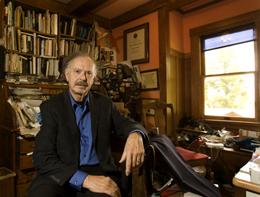Independent analysis confirms earlier results but aims for greater transparency.
 Richard Muller led the Berkeley Earth Surface Temperature Group's review of global climate data.Dan Tuffs/Getty Images
Richard Muller led the Berkeley Earth Surface Temperature Group's review of global climate data.Dan Tuffs/Getty ImagesWhat is the Berkeley Earth Surface Temperature study?
Until now, instrumental temperature records dating back to the middle of the nineteenth century have been compiled by three main research groups: NASA's Goddard Institute for Space Studies in Greenbelt, Maryland; the US National Oceanic and Atmospheric Administration in Washington DC; and a collaboration between Britain's Met Office and the Climatic Research Unit at the University of East Anglia in Norwich, UK. All three records were developed in different ways, using separate, but overlapping, sets of data. By and large, all three studies line up fairly well as they document rising temperatures, particularly the sharp spike in recent decades, but that hasn't halted criticism from climate sceptics regarding the quality of the data and the rigor of the analysis.
What was the research team's goal, and did they achieve it?
Muller says he listened to the sceptics and decided that an independent analysis was in order. He and his team decided to tackle the temperature record independently, on the basis of first principles. They say their results line up with previously published studies and suggest that the average global land temperature has risen by roughly 0.9 °C since the 1950s.
Muller says he is surprised at how well the findings line up with previous analyses, which he takes as evidence that the various scientific teams working on these data did indeed go about their work "in a truly unbiased manner".
What did the team do differently?
The Berkeley researchers developed their own statistical methods so that they could use data from virtually all of the temperature stations on land — some 39,000 in all — whereas the other research groups relied on subsets of data from several thousand sites to build their records. This meant that they also had to figure out ways to handle shorter temperature records from instruments or stations where the record was interrupted.
Muller and his team also used a different approach to analysing the data. Scientists working on the earlier studies adjusted raw data to account for differences in the time of day when readings were made, for example, or for higher temperatures caused by the urban heat island effect, in which cities tend to be warmer than natural landscapes. Muller says his team included the raw data in its analysis and then applied standard statistical techniques to remove outliers.
Is there an advantage to tackling the problem this way?
The team claims that this method is more transparent than those used by the other groups. And it may be true that this kind of analysis could make it easier for outside groups to reproduce and analyse the study.
Has the study been peer-reviewed?
Not yet, which is a common criticism among many scientists who were already convinced that the earlier analyses were solid. The Berkeley team is preparing to submit four papers to the Journal of Geophysical Research for peer review. One paper describes the method and how it was applied to the larger temperature record. Another discusses the various methods for dealing with known problems and biases in the temperature record. A third focuses on the urban heat island effect and a fourth looks specifically at temperature stations that have been labelled as problematic by sceptics.
Is the latest study likely to win over any sceptics?
It's too early to tell what kind of effect the report will have, but there are already signs of scepticism among the sceptics. Nonetheless, Steve McIntyre, who runs the sceptic blog Climate Audit, said in an interview that the team deserves credit for going back to the primary data and doing the work. Although he hasn't gone through the papers in detail, he is already questioning the results reported by the Berkeley team regarding the questionable research stations and the urban heat island effect. McIntyre, a statistician, says he has already run a preliminary analysis and was unable to reproduce the results reported by Muller and his crew.
What comes next?
Now we wait to see how the peer-review process plays out. Meanwhile, the Berkeley team will post a complete file of the temperature record on its website by the end of this week. "Previously, the data were spread over 15 different databases with almost as many different formats, and a great deal of overlap," Muller says. "I would like to think that we are opening this field up to a much larger community by reducing the barrier to entry."

Không có nhận xét nào:
Đăng nhận xét